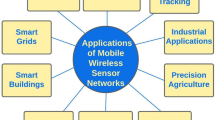Abstract
Effective techniques for extending lifetime in multi-hop wireless sensor networks include duty cycling and, more recently introduced, cooperative transmission (CT) range extension. However, a scalable MAC protocol has not been presented that combines both. An On-demand Scheduling Cooperative MAC protocol (OSC-MAC) is proposed to address the energy hole problem in multi-hop wireless sensor networks (WSNs). By combining an on-demand strategy and sensor cooperation intended to extend range, OSC-MAC tackles the spatio-temporal challenges for performing CT in multi-hop WSNs: cooperating nodes are neither on the same duty cycle nor are they necessarily in the same collision domain. We use orthogonal and pipelined duty-cycle scheduling, in part to reduce traffic contention, and devise a reservation-based wake-up scheme to bring cooperating nodes into temporary synchrony to support CT range extension. The efficacy of OSC-MAC is demonstrated using extensive NS-2 simulations for different network scenarios without and with mobility. Compared with existing MAC protocols, simulation results show that while we explicitly account for the overhead of CT and practical failures of control packets in dense traffic, OSC-MAC still gives 80–200 % lifetime improvement.













Similar content being viewed by others
Notes
Routing is typically implemented in software, and our MAC protocol could potentially be implemented with open source driver.
References
Akyildiz, I. F., Su, W., Sankarasubramaniam, Y., & Cayirci, E. (2002). Wireless sensor networks: A survey. Computer Networks, 38(4), 393–422.
Alamouti, S. M. (1998). A simple transmit diversity technique for wireless communications. IEEE Journal on Selected Areas in Communications, 16(8), 1451–1458.
Anastasi, G., Falchi, A., Passarella, A., Conti, M., & Gregori, E. (2004). Performance measurements of motes sensor networks. In Proceedings of the 7th ACM international symposium on modeling, analysis and simulation of wireless and mobile systems, ACM (pp. 174–181) New York, USA, MSWiM.
B200mini. (2016). USRP-B200mini. Ettus http://www.ettus.com/product/details/USRP-B200mini.
Badia, L., Levorato, M., Librino, F., & Zorzi, M. (2010). Cooperation techniques for wireless systems from a networking perspective. IEEE Wireless Communications, 17(2), 89–96.
Bianchi, G. (2000). Performance analysis of the IEEE 802.11 distributed coordination function. IEEE Journal on Selected Areas in Communications, 18(3), 535–547.
Buettner, M., Yee, G. V., Anderson, E., & Han, R. (2006). X-MAC: A short preamble MAC protocol for duty-cycled wireless sensor networks. In Proceedings of sensor systems, ACM, New York, USA.
Chakrabarti, A., Sabharwal, A., & Aazhang, B. (2003). Using predictable observer mobility for power efficient design of sensor networks. In Proceedings of the 2nd international conference on information processing in sensor networks, IPSN’03 (pp 129–145). Springer.
Chang, Y. J., Jung, H., & Ingram, M. A. (2010). Demonstration of a new degree of freedom in wireless routing: Concurrent cooperative transmission. In Proceedings of ACM workshop on hot topics in embedded networked sensors.
Dai, H., & Han, R. (2003). A node-centric load balancing algorithm for wireless sensor networks. IEEE GLOBECOM IEEE, 1, 548–552.
Fei, T., Wan, T., Rong, X., Lei, S., & Young-Chon, K. (2011). P-MAC: A cross-layer duty cycle MAC protocol towards pipelining for wireless sensor networks. IEEE ICC, 2011, 1–5.
Goh, H., Sim, M., & Ewe, H. (2006). Energy efficient routing for wireless sensor networks with grid topology. Embedded and ubiquitous computing (Vol. 4096, pp. 834–843). Berlin, Heidelberg: Springer.
Gokturk, M., Gurbuz, O., & Erkip, E. (2012). Recomac: A cross-layer cooperative network protocol for wireless ad hoc networks. In 5th international conference on new technologies, mobility and security (NTMS) (pp 1–7).
Guntupalli, L., Lin, J., Weitnauer, M., & Li, F. (2014). ACT-MAC: An asynchronous cooperative transmission mac protocol for WSNs. In IEEE international conference on communications Workshops (ICC) (pp. 848–853).
Haykin, S., & Moher, M. (2004). Modern Wireless Communication. Upper Saddle River, NJ: Prentice-Hall Inc.
Hongzhi, J., Ingram, M., & Li, F. (2011). A cooperative lifetime extension MAC protocol in duty cycle enabled wireless sensor networks. In MILCOM (pp. 896 –901).
Jakllari, G., Krishnamurthy, S., Faloutsos, M., Krishnamurthy, P., & Ercetin, O. (2007). A cross-layer framework for exploiting virtual miso links in mobile ad hoc networks. IEEE Transactions on Mobile Computing, 6(6), 579–594.
Jin Woo, J., & Ingram, M. A. (2010). Residual-energy-activated cooperative transmission (REACT) to avoid the energy hole. In Proceedings of IEEE international conference on communications workshops (ICC).
Jung, J. W., & Weitnauer, M. A. (2013). On using cooperative routing for lifetime optimization of multi-hop wireless sensor networks: Analysis and guidelines. IEEE Transactions on Communications, 61(99), 1–11.
Kansal, A., Somasundara, A. A., Jea, D. D., Srivastava, M. B. & Estrin, D. (2004). Intelligent fluid infrastructure for embedded networks. In Proceedings of the 2nd international conference on mobile systems, applications, and services, ACM, MobiSys ’04 (pp. 111–124).
Kar, K., Kodialam, M., Lakshman, T., & Tassiulas, L. (2003). Routing for network capacity maximization in energy-constrained ad-hoc networks. In Proceedings of IEEE INFOCOM.
Laneman, J. N., Tse, D. N. C., & Wornell, G. W. (2004). Cooperative diversity in wireless networks: Efficient protocols and outage behavior. IEEE Transactions on Information Theory, 50(12), 3062–3080.
Li, J., & Mohapatra, P. (2005). An analytical model for the energy hole problem in many-to-one sensor networks. In Proceedings of IEEE VTC
Lian, J., Chen, L., Naik, K., Otzu, T., & Agnew, G. (2004). Modeling and enhancing the data capacity of wireless sensor networks. IEEE Monograph on Sensor Network Operations, 2, 91–138.
Lian, J., Naik, K., & Agnew, G. B. (2006). Data capacity improvement of wireless sensor networks using non-uniform sensor distribution. International Journal of Distributed Sensor Networks, 2(2), 121–145.
Lin, J., & Ingram, M. A. (2012). SCT-MAC: A scheduling duty cycle MAC protocol for cooperative wireless sensor networks. In IEEE international conference on Communication(ICC).
Lin, J., & Ingram, M. A. (2013). OSC-MAC: Duty cycle scheduling and cooperation in multi-hop wireless sensor networks. In Proceedings of IEEE wireless communications and networking (WCNC).
Lin, J., Jung, H., Chang, Y. J., Jung, J. W., & Weitnauer, M. A. (2015). On cooperative transmission range extension in multi-hop wireless ad-hoc and sensor networks: A review. Ad Hoc Networks, 29, 117–134.
Lin, Q., & Weitnauer, M. A. (2015a). Diversity in synchronization for scheduled OFDM time-division cooperative transmission. In IEEE military communications conference (MILCOM).
Lin, Q., & Weitnauer, M. A. (2015b). SINR analysis and energy allocation of preamble and training for time division CT with range extension. In IEEE military communications conference (MILCOM).
Lin, J., & Weitnauer, M. A. (2016). Modeling of multihop wireless sensor networks with mac, queuing, and cooperation. International Journal of Distributed Sensor Networks, 2016. Article ID: 5258742. doi:10.1155/2016/5258742.
Liu, A. F., Wu, X. Y., & Gui, W. H. (2008). Research on energy hole problem for wireless sensor networks based on alternation between dormancy and work. In The 9th international conference for Young Computer Scientists (pp. 475–480).
Luo, J., & Hubaux, J. P. (2005). Joint mobility and routing for lifetime elongation in wireless sensor networks. In Proceedings IEEE 24th IEEE INFOCOM (Vol. 3, pp. 1735–1746).
Luo, J., Blum, R., Cimini, L., Greenstein, L., & Haimovich, A. (2007). Decode-and-forward cooperative diversity with power allocation in wireless networks. IEEE Transactions on Wireless Communications, 6(3), 793–799.
Luo, J., Panchard, J., Pirkowski, M., Grossglauser, M., & Hubaux, J. P. (2006). Mobiroute: Routing towards a mobile sink for improving lifetime in sensor networks. In Distributed computing in sensor systems (Vol. 4026) Berlin, Heidelberg: Springer.
Pei, L., Zhifeng, T., Sathya, N., Thanasis, K., & Shivendra, S. P. (2007). CoopMAC: A cooperative MAC for wireless LANs. IEEE JSAC, 25(2), 340–354.
Polastre, J., Hill, J., & Culler, D. (2004). Versatile low power media access for wireless sensor networks. In The second ACM conference on embedded networked sensor systems (SenSys).
Rappaport, T. (2001). Wireless communications: Principles and practice. Upper Saddle River, NJ: Prentice Hall PTR.
Saad, L. B., & Tourancheau, B. (2011). Sinks mobility strategy in ipv6-based WSNs for network lifetime improvement. In 2011 4th IFIP international conference on new technologies, mobility and security (NTMS) (pp. 1–5).
Salhieh, A., Weinmann, J., Kochhal, M., & Schwiebert, L. (2001). Power efficient topologies for wireless sensor networks. In International conference on parallel processing (Vol. 2001, pp. 156–163).
Sangman, M., & Chansu, Y. (2011). A cooperative diversity-based robust MAC protocol in wireless ad hoc networks. IEEE Transactions on Parallel and Distributions Systems, 22, 353–363.
Sendonaris, A., Erkip, E., & Aazhang, B. (2003). User cooperation diversity. Part II. Implementation aspects and performance analysis. IEEE Transactions on Communications, 51(11), 1939–1948.
Stoleru, R., & Stankovic, J. (2004). Probability grid: A location estimation scheme for wireless sensor networks. In IEEE SECON.
Sun, Y., Du, S., Gurewitz, O., & Johnson, D. B. (2008). DW-MAC: A low latency, energy efficient demand-wakeup MAC protocol for wireless sensor networks. In Proceedings of MobiHoc 2008, ACM.
Sun, Y., Gurewitz, O., & Johnson, D. B. (2008). RI-MAC: A receiver-initiated asynchronous duty cycle MAC protocol for dynamic traffic loads in wireless sensor networks. In SenSys, ACM.
Talarico, S., Matthew, C. V., & Thomas, R. H. (2014). Unicast barrage relay networks: Outage analysis and optimization. In Proceedings of IEEE MILCOM (pp. 537–543).
Wang, ZM., Basagni, S., Melachrinoudis, E., & Petrioli, C. (2005). Exploiting sink mobility for maximizing sensor networks lifetime. In Proceedings of the 38th annual Hawaii international conference on system sciences, HICSS (Vol. 09).
Wang, W., Srinivasan, V., & Chua, K. C. (2005). Using mobile relays to prolong the lifetime of wireless sensor networks. In Proceedings of the 11th annual international conference on mobile computing and networking, ACM (pp. 270–283).
Wei, Y., Heidemann, J., & Estrin, D. (2002). An energy-efficient MAC protocol for wireless sensor networks. In Proceedigs of IEEE INFOCOM.
Winter, T. (2012). RPL: IPv6 routing protocol for low power and lossy networks. In rfc6550.
Wu, X., Chen, G., & Das, S. K. (2008). Avoiding energy holes in wireless sensor networks with nonuniform node distribution. IEEE Transactions on Parallel and Distributed Systems, 19, 710–720.
Ye, W., Silva, F., & Heidemann, J. (2006). Ultra-low duty cycle MAC with scheduled channel polling. In Proceedings of the 4th international conference on Embedded networked sensor systems, ACM (pp. 321–334).
Yong, Z., Ju, L., Lina, Z., Chao, Z., & He, C. (2011). Link-utility-based cooperative MAC protocol for wireless multi-hop networks. IEEE Transactions on Wireless Communications, 10(3), 995–1005.
Zhao, B., & Valenti, M. (2005). Practical relay networks: A generalization of hybrid-ARQ. IEEE Journal on Selected Areas in Communications, 23(1), 7–18.
Acknowledgements
The authors gratefully acknowledge support for this research from the US National Science Foundation under Grant CNS-1017984.
Author information
Authors and Affiliations
Corresponding author
Additional information
Mary Ann Weitnauer was formerly Mary Ann Ingram.
Rights and permissions
About this article
Cite this article
Lin, J., Weitnauer, M.A. Range extension cooperative MAC to attack energy hole in duty-cycled multi-hop WSNs. Wireless Netw 24, 1419–1437 (2018). https://doi.org/10.1007/s11276-016-1408-7
Published:
Issue Date:
DOI: https://doi.org/10.1007/s11276-016-1408-7




